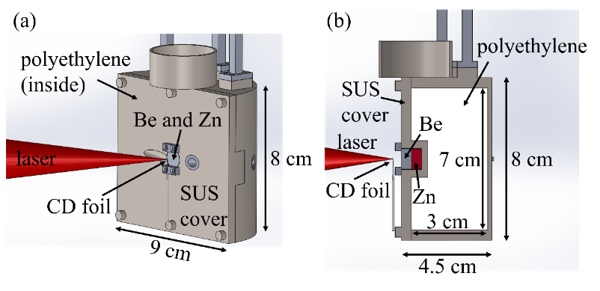Progress of high-power laser science enabled us to accelerate various particles through laser-plasma interactions. At present, photons, electrons, ions, and neutrons are generated by laser facilities. One of the possible applications for these laser-driven particles is the production of medial radioisotopes by a compact laser system inside of hospitals. Radioisotopes which emit gamma-rays such as 99mTc (half-life 6.02 h) and 18F (half-life 1.8 h) are used for single-photon emission computed tomography (SPECT) and position emission tomography (PET) in medical diagnostic scans. In addition, radioisotopes that radiate beta-rays or alpha-rays with half-lives of a few days could be used for cancer therapy. When the medication including such radioisotopes is administered to a patient, it is accumulated primarily in tumours and subsequently kill effectively the cancer cells by radiation of beta-rays (alpha-rays). At present, most medical radioisotopes have been provided from large facilities of nuclear reactors and accelerators, and they have been transported to hospitals. However, when medical radioisotopes can be produced in hospitals, it is possible to diagnose and treat patients in a flexible manner. In fact, a positron emitter 18F is produced by compact cyclotron accelerators located inside of hospitals and used for PET, because 18F which could be effectively produced by proton-induced nuclear reactions and small proton accelerators has been realized.
One of the candidates for further medical radioisotopes is 67Cu with a half-life of 2.58 d. 67Cu decays to the daughter nucleus 67Zn through an emission of a beta-ray, and subsequently it may radiate gamma-rays. During the therapy, a radiopharmaceutical with 67Cu administered in a patient body kill effectively the cancer cells by beta-rays, and the gamma-rays radiated from 67Cu are suitable for SPECT imaging to identify the positions of the tumours. However, 67Cu cannot be produced by methods already used to produce other medical radioisotopes. Thus, various new production methods have been studied for the future operation. They are nuclear reactions with protons and deuterons provided from ion accelerators, photo-disintegration nuclear reactions with high-energy gamma-rays provided from electron accelerators, and nuclear reactions with high-energy neutrons from accelerators.
Researchers of the article "Feasibility study of laser-driven neutron sources for pharmaceutical applications" (Takato Mori, Akifumi Yogo, Yasunobu Arikawa, Takehito Hayakawa, Seyed R. Mirfayzi, Zechen Lan, Tianyun Wei, Yuki Abe, Mitsuo Nakai, Kunioki Mima, Hiroaki Nishimura, Shinsuke Fujioka, Ryosuke Kodama. Feasibility study of laser-driven neutron sources for pharmaceutical applications[J]. High Power Laser Science and Engineering, 2023, 11(2): 02000e20) have proposed 67Cu production using laser-driven neutron source (LDNS) in a compact laser system located inside of hospitals and carried out a proof-of-principle experiment using the petawatt laser for fast ignition experiments (LFEX) laser system at the Institute of Laser Engineering (ILE) in Osaka University. LDNS has been developed in the world, but most applications require low-energy neutrons in thermal energy region around 0.025 eV. It was pointed out that the energies of neutrons generated primarily from LDNS are suitable for production of 67Cu via the neutron-induced reactions on Zn isotopes.
To accelerate ions, four laser pulses provided by LFEX were focused on a target with an intensity of approximately 1.5 x 1019 W/cm2 and with duration of 1.5 ps in the full width at half maximum (FWHM). As the target, a deuterated carbon foil with a thickness of 5 μm was used. A plasma was induced by the laser and subsequently ions of protons and deuterons were accelerated from the plasma via the target normal sheath acceleration (TNSA). The accelerated protons and deuterons have continuous energies, and the maximum energies of the protons and deuterons using LFEX were typically 30 MeV and 20 MeV, respectively. A Be block with a size of φ10 mm×5 mm was installed 4-mm downstream from the CD foil. High-energy neutrons are predominantly generated by the 9Be(p, n)9B reaction with high-energy protons. To produce 67Cu, a natural Zn target with a size of φ10 mm×5 mm was placed behind of the Be target. Unstable isotopes were produced via nuclear reactions with the neutrons on stable isotopes of Zn. Eleven minutes after the laser shot, the Zn target was moved from the target chamber to the measurement position and the gamma-rays radiated from the unstable isotopes were measured with high-energy resolution detectors. 67Cu could be produced by the 67Zn(n, p) 67Cu and 68Zn(n, np) 67Cu reactions with the high-energy neutrons. 67Cu production using LDNS was verified and the obtained atom number using only single laser shot was (3.3±0.5) x 105, corresponding to the raidoactivity of 1.0±0.2 Bq.
The expected radioactivity of 67Cu using a more optimized target system was calculated using the PHITS Monte Carlo simulation code based on the experimental result. It was suggested that when a high-power laser with the optimized target system is operated with a frequency of 10 Hz and a time of 10,000 s, 270 MBq of 67Cu could be produced. This result suggests a possibility of production of medical radioisotope using LDNS inside of hospitals although further studies are required for more realistic estimation.

Figure Caption: Experimental setup for the laser shot to generate neutrons. The laser is focused on the CD foil target. The Be neutron generation target is placed 4-mm downstream from the CD foil. Behind the Be target, the natural Zn target was located in the hole at the center of the front surface.


